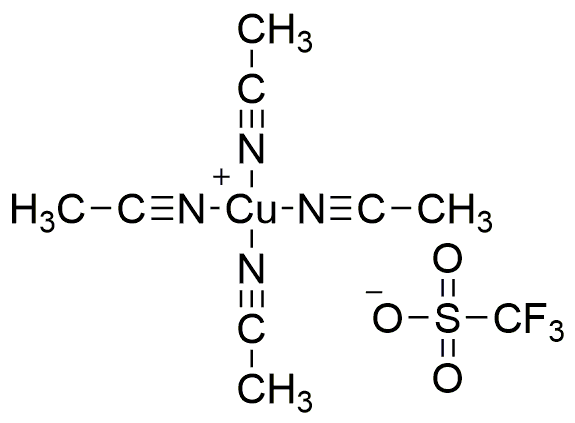Tetrakis(acetonitrile)copper(I) trifluoromethanesulfonate is widely utilized in research focused on:
- Catalysis: This compound serves as an effective catalyst in various organic reactions, enhancing reaction rates and improving yields in synthetic chemistry.
- Electrochemistry: It is employed in electrochemical studies, particularly in the development of sensors and batteries, due to its unique electrochemical properties.
- Material Science: The compound is used in the synthesis of advanced materials, including conductive polymers and nanomaterials, which have applications in electronics and photonics.
- Pharmaceutical Development: It plays a role in drug synthesis, aiding in the creation of complex organic molecules that are crucial for pharmaceutical research.
- Environmental Chemistry: This chemical is involved in studies related to environmental remediation, helping to develop processes for removing pollutants from water and soil.
Informations générales
Propriétés
Sécurité et réglementation
Applications
Tetrakis(acetonitrile)copper(I) trifluoromethanesulfonate is widely utilized in research focused on:
- Catalysis: This compound serves as an effective catalyst in various organic reactions, enhancing reaction rates and improving yields in synthetic chemistry.
- Electrochemistry: It is employed in electrochemical studies, particularly in the development of sensors and batteries, due to its unique electrochemical properties.
- Material Science: The compound is used in the synthesis of advanced materials, including conductive polymers and nanomaterials, which have applications in electronics and photonics.
- Pharmaceutical Development: It plays a role in drug synthesis, aiding in the creation of complex organic molecules that are crucial for pharmaceutical research.
- Environmental Chemistry: This chemical is involved in studies related to environmental remediation, helping to develop processes for removing pollutants from water and soil.
Documents
Fiches de données de sécurité (FDS)
La FDS fournit des informations de sécurité complètes sur la manipulation, le stockage et l’élimination du produit.
Spécifications du produit (PS)
Le PS fournit une description complète des propriétés du produit, notamment sa composition chimique, son état physique, sa pureté et les exigences de stockage. Il détaille également les plages de qualité acceptables et les applications prévues du produit.
Certificats d'analyse (COA)
Recherchez des certificats d'analyse (COA) en saisissant le numéro de lot du produit. Les numéros de lot et de lot se trouvent sur l'étiquette d'un produit, après les mots « Lot » ou « Lot de fabrication ».
Numéro de catalogue
Numéro de lot/série
Certificats d'origine (COO)
Ce certificat d'exploitation confirme le pays dans lequel le produit a été fabriqué, et détaille également les matériaux et composants utilisés et s'il est issu de sources naturelles, synthétiques ou autres sources spécifiques. Ce certificat peut être requis pour les douanes, le commerce et la conformité réglementaire.
Numéro de catalogue
Numéro de lot/série
Fiches de données de sécurité (FDS)
La FDS fournit des informations de sécurité complètes sur la manipulation, le stockage et l’élimination du produit.
DownloadSpécifications du produit (PS)
Le PS fournit une description complète des propriétés du produit, notamment sa composition chimique, son état physique, sa pureté et les exigences de stockage. Il détaille également les plages de qualité acceptables et les applications prévues du produit.
DownloadCertificats d'analyse (COA)
Recherchez des certificats d'analyse (COA) en saisissant le numéro de lot du produit. Les numéros de lot et de lot se trouvent sur l'étiquette d'un produit, après les mots « Lot » ou « Lot de fabrication ».
Numéro de catalogue
Numéro de lot/série
Certificats d'origine (COO)
Ce certificat d'exploitation confirme le pays dans lequel le produit a été fabriqué, et détaille également les matériaux et composants utilisés et s'il est issu de sources naturelles, synthétiques ou autres sources spécifiques. Ce certificat peut être requis pour les douanes, le commerce et la conformité réglementaire.


